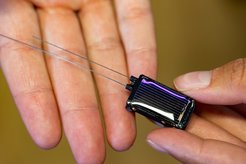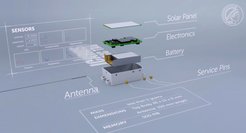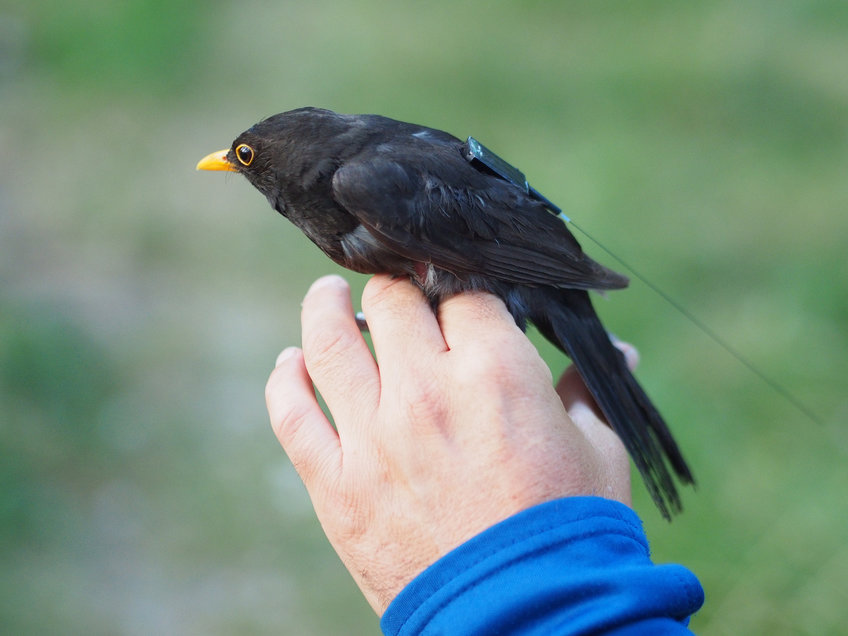Animals on the air
Transmitters are at the heart of Icarus and are being specially developed for this project. They need to be small so that they don't impede the animals wearing them. They need to be able to withstand cold, heat, moisture and dust. And they need to maintain enough power to transmit their data by radio – over months or years – to a receiver station located up to 600 kilometres away in space.

The Icarus transmitters, which also have a GPS function, weigh a mere five grams each and are barely bigger than a euro cent coin. The smallest transmitters available prior to Icarus weighed between 15 and 20 grams. The problem is that animal species that weigh only 100 grams, such as the blackbird (Turdus merula), cannot be fitted with such transmitters. In order for a transmitter not to affect an animal's behaviour or chances of survival, it must be a maximum of five percent of the animal's body weight. Studies have shown that such transmitters do not negatively affect the behavior of the animals. The important thing is that the transmitters are light and small enough and do not impede the animal's movements. They must also be discreet, so that they do not make the animals easy prey for predators.
Nevertheless, there is still a residual risk of course. The Icarus scientists are therefore only conducting those projects the expected beneficial effect of which far outweighs the potential consequences for the animals. Each individual study must also be approved in advance by the competent authorities. This also includes conducting a study in such a way that the results have the most informative value as possible, whether that is with regard to protecting a species, researching behaviour or forecasting natural disasters. In addition, the researchers are also making the results freely available via the Movebank online database. The findings can thus be used by scientists, conservationists and politicians around the world.
Tags are easy to attach

The researchers first need to capture the animals and attach the transmitters. Various techniques are used to do this: Martin Wikelski has developed a silicon harness, for example, which he uses to secure a transmitter to a bird. The straps are elasticated and fit the animal's body even snugly if it gains or loses weight. The harness is also concealed by the feathers and is thus virtually invisible. All of this ensures that the transmitter does not impact negatively on the animals' lives and behavior.
It usually only takes a few minutes to attach the transmitter. In some cases, the researchers measure the animals or take blood, feather or hair samples. The animals are individually tagged (using a bird ring for example), so that transmitters and birds are clearly identifiable. The birds are then released into the wild again and shortly afterwards continue on with their natural activities. The transmitter can now collect and transmit data – potentially over the entire lifetime of an animal: scientists have observed storks in this way for ten years.
The transmitters consist of a plastic housing, a lithium-ion battery, an application-specific radio module and a basic module for controlling the transmitter's functions and sensors: accelerometer, magnetometer, temperature, humidity, and pressure sensor as well as a GPS module which calculates an exact location to a few metres. Some sensors even determine the position with an accuracy of less than one metre. The battery supplies the power for taking the measurements and transferring the data. The solar cell on the surface recharges the battery. The transmitter has two antennas, one 200mm long for radio transmission, and one 50mm long for the GPS receiver.
Minimum energy consumption

The transmitter is optimised for minimum energy consumption. The GPS module and the radio-transmitted signal need the most energy. The transmitter therefore runs in stand-by mode most of the time. This is only briefly interrupted to record and store the data on the sensors. Otherwise, almost all other systems on the transmitter are switched off if there is no contact with the receiver station or if the transmitter is not actually capturing sensor data.
The development of the new Icarus transmitters is completed. In the current testing phase, the scientists deploy around 5,000 transmitters in the various Icarus projects.
The transmission technology will continue to be of great importance, as sensors weighing five grams are still too heavy for many animal species: 70 percent of bird species and 65 percent of mammal species, not to mention amphibians or insects, cannot be equipped with sensors using the current technology. The next generation of Icarus sensors will therefore weigh just one gram.


